QUESTEC MECHANICAL
Training, educating, and celebrating the work of talented tradesmen through hands-on learning.



Training, educating, and celebrating the work of talented tradesmen through hands-on learning.






DID YOU KNOW?
Our business is named after our kids, Jeffrey & Sophia!

Jeffrey, in particular, loves to “go to work” with Daddy and help with whatever he can (and boy, does he work!) When he grows up he wants to be a firefighter and mow lawns like Dad.


Sophia likes to work behind the scenes with Mommy, running errands, taking pictures, and bringing Daddy lunch. While she works closely with Mommy, Sophia is definitely a Daddy’s girl. She also wants to be a firefighter some day!
Fully Insured
Reliable & Trustworthy
& Experienced
LOCALLY OWNED & OPERATED
(573) 864-5071 jscomolawns.com
FIND US ON FACEBOOK J&S Lawn & Landscape LLC
EDITORIAL
Erica Pefferman, Publisher Erica@comocompanies.com
Kim Ambra, Editor-in-Chief Kim@comocompanies.com

Jodie Jackson Jr, Digital Editor Jodie@comocompanies.com
DESIGN
Kate Morrow, Creative Director Kate@comocompanies.com

Jordan Watts, Senior Designer Jordan@comocompanies.com
MARKETING
Charles Bruce, Director of Sales Charles@comocompanies.com

Amanda Melton, Director of Account Services Amanda@comocompanies.com
J.J. Carlson, Director of Web Development jj@comocompanies.com


Sarah Hempelmann, Marketing Representative Sarah@comocompanies.com



Becky Roberts, Marketing Representative Becky@comocompanies.com
MANAGEMENT
Erica Pefferman, President Erica@comocompanies.com


CONTRIBUTING PHOTOGRAPHERS
Rebecca Allen, Tony Jinson, Chris Padgett
CONTRIBUTING WRITERS
Taylor Ambra, Lauren Sable Freiman, Lydia Graves, Jodie Jackson, Matt McCormick, Brian Milner, Steve Spellman, Alexa Summers, Brian Toohey, Michelle Terhune, Jennifer Truesdale, Emmi Weiner
SUBSCRIPTIONS
Magazines are $5.95 an issue. Subscription rate is $54 for 12 issues for one year or $89 for 24 issues for two years. Subscribe at comobusinesstimes.com or by phone. COMO Business Times is published monthly by e COMO Companies.
OUR MISSION STATEMENT COMO Business Times and comobusinesstimes.com strive to be Columbia’s leading source for timely and comprehensive news coverage of the local business community. is publication is dedicated to being the most relevant and useful vehicle for the exchange of information and ideas among Columbia’s business professionals.
Copyright e COMO Companies, 2023 All rights reserved. Reproduction or use of any editorial or graphic content without the express written permission of the publisher is prohibited.
Iam an avid learner. I love to learn about all kinds of things. On any given Saturday morning, you’ll find me coffee in hand learning how to propagate succulents or reading a business book. I’m a big fan of the philosophy that “you will be the same person in five years as you are today except for the people you meet and the books you read” (Charlie Tremendous Jones).
2023 has been a great year of learning for me primarily because of the adventure I’m on after being selected as a part of this year’s cohort for the Greater Missouri Leadership Challenge. Established in 1990, the Greater Missouri Leadership Challenge is the marquee program of the Greater Missouri Leadership Foundation. The Challenge is a year-long statewide traveling symposium that provides women leaders with education and experiences to assist them in addressing critical issues facing our state. The sessions begin in March and conclude in November of each year.
• Participants meet for four, three-day sessions combining:
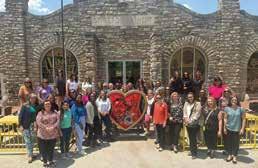
• Continuing education in leadership development

• Discussion of statewide policy issues

• Exposure to the philosophies and thoughts of the state’s business, cultural, educational, and political leaders

• Expanding professional networks & channels of communication

So far, I have completed two of these sessions, the first being in Columbia and Jefferson City to focus on education and government and the second in Kansas City to focus on community development and social issues. As a person who writes about Columbia for a living, I was pleasantly surprised to learn even more about our city. I learned about plans for our second nuclear research reactor and was able to tour Next Gen. We toured the prison in Jefferson City and learned how to lobby at the capital for issues that are important to us.
However, the most impactful event of this challenge for me thus far has been the trip to Kansas City. We toured several amazing nonprofits including Operation Breakthrough, Veterans Community Project (tiny home community), and Pawsperity. We learned from a panel of women leaders on how they orchestrated the vast improvement of a mostly abandoned community by partnering with the artist community.
When I say I was very convicted by this trip, I mean I came home changed by what I saw. I have been thinking about how my marketing firm can focus on missional marketing. I immediately set appointments with leaders in our non-profit community such as Jane Williams (Love Columbia) and Darin Pries (CMCA) to see how what I witnessed compares to what we do. I discussed our affordable housing accessibility issue with Randy Cole at the Columbia Housing Authority as well as the wrap around services offered by and through his organization. Ultimately, I was moved to put my name in the hat for the open seat on the Housing and Community Development Commission and was approved and appointed to that role. I’m thrilled to act on what I learned here in COMO. I’m thrilled to keep telling the stories in these pages of the organizations doing amazing work. And I’m thrilled to see how I can be part of the solution for our housing crisis. What do you want to learn more about and how can we help with that? Let me know.










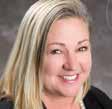

CBT ’s advisory board is made up of industry leaders and small business owners who help ensure CBT ’s content is relevant to our local business community.


e 203 strives to make game day and every day a little more fun through clothes. Owner Jenna Shockley says she started the online boutique in 2022 as a passion project.
“I started the boutique because my family and I are big Chiefs fans and wanted to create a place to buy game day out ts. We obviously have an MU collection as well,” she says. “We print most of our shirts in-house. Not only do we o er game day shirts and sweatshirts, but we do also have a retail side where we sell pants, tops, and accessories.”

Shockley explains the inspiration behind naming the boutique.
“A lot of people wonder where the name 203 Boutique comes from. 203 stands for the last three digits of our zip code (65203),” she says. “I wanted to pay homage to the area and 573 was already taken.”
203 Boutique o ers free local pickup and can ship anywhere within the United States.
203Boutique.com
Facebook: @203 Boutique
Instagram: @the203boutique
Dolli’s Designs LLC is a luxury balloon company committed to creating unique, distinctive, and memorable experiences. e company specializes in balloon displays for corporate events and social events such as birthday parties, baby showers, and engagement celebrations.
“Dolli’s Designs is most known for the luxury look we provide by using a variety of textures, colors, and add-ins that we incorporate into our balloon designs, says co-owner Shalina “Dolli” Reed. “We o er balloon decor that is tailored to the event’s theme by incorporating details such as orals, themed foil balloons, and custom decals.”

Reed says Dolli’s Designs is also known for professional classic balloon decor such as balloon arches and columns. Reed is co-owner along with Treana Cason. e owners say they bring genuine love to the community.
“We take every client’s vision for their once in a lifetime experience extremely seriously,” Reed emphasizes. “We not only o er the highest quality balloon decor and event decor, but we also o er the highest quality customer service.”
dollisdesigns.com
573-291-2039
Uplifted Salon’s claim to fame is o ering lived-in color customized to perfectly t your lifestyle.
“As a healthy hair salon, each of our color services includes a cut or luxury post-color treatment to truly hydrate and preserve the integrity of the hair,” says owner Kaylee Concannon. “We also are well known for bridal hair and makeup services and have just started o ering extensions services this year.”
After welcoming a child in 2016, Concannon found herself under the heavy weight of postpartum depression.
“I suddenly felt I was part of a very ugly industry full of toxic thoughts and ideas surrounding beauty. More than anything, I wanted to be a role model for my daughter,” she continues. “ e industry had lost its lust for me and the work environment I was in only fed into my doubts. From there, Uplifted Salon was born.”
Uplifted Salon aims to be an escape from your busy day-to-day. Concannon says she strives to make every step of the process enjoyable and customizable.
3115 Falling Leaf Ct. Suite 101 Upliftedsalon.com CBT

The Columbia Chamber of Commerce is pleased to welcome Matthew Rogers as its new director of membership. Rogers is a Columbia native and holds a bachelor’s degree in business management and marketing from College of the Ozarks.
He owned a small business in Columbia for 10 years, during which time he developed a love of the community and especially the business community. He looks forward to serving the community in his new role at the Chamber, where he will be the first line of communication servicing member needs and sharing with new members all that the Chamber has to offer.
Coil Construction is pleased to announce multiple team member promotions.
Don Prose, P.E., P.M.P. has been promoted to senior project manager. Prose started with Coil in 2011 as a project manager. He earned his project manager professional certification in 2020 and his professional engineer designation in 2021.


Cody Logsdon has been promoted to director of regional operations. Logsdon grew up in the residential construction industry and started at Coil in 2012 as a project manager.


Katie Partise has been promoted to senior project manager. She joined the Coil team in 2014 as an assistant project manager, working her way up to project manager and now becoming Coil’s first female senior project manager.

Ron Hall has been promoted to director of field operations. He joined Coil as a project manager in 2019, overseeing field operations for the regional operations division.
MFA OIL
MFA Oil Company, a farmerowned energy supply cooperative, announces the promotions of Jennifer Bach and Charlie Alexander.
Jennifer Bach has been promoted to MFA’s executive team as vice president of Break Time operations. She has worked in the Break Time division of MFA Oil for 25 years, most recently as senior director of operations for the company’s 71 Break Time stores. Charlie Alexander has joined the executive team as vice president of Big O Tires operations. Alexander leads the cooperative’s 36 Big O Tires automotive service centers.
Stephen Colbert, MD, was promoted to the chief of Plastic and Reconstructive Surgery Division within the Department of Surgery at MU Health Care. Prior to his promotion, Dr. Colbert

served as a faculty member of the division since 2006, and chief of plastic surgery at the Harry S. Truman Memorial VA Hospital for 11 years.
Dr. Colbert also serves as the director of the Plastic Surgery Residency Program, clerkship director for surgery, and chair of the Clinical Clerkship Steering Committee at the University of Missouri School of Medicine. Dr. Colbert completed medical school and residency at the University of Missouri School of Medicine and fellowship at Washington University in St. Louis.
Annette Triplett, a nonprofit business leader and longtime advocate for transportation equity, has stepped down from her role as chief financial officer and chief operating officer of Local Motion. Triplett has been with Local Motion for more than 10 years. Triplett was hired as CEO of Local Motion (previously PedNet Coalition) in 2013 after the departure of founding executive firector Ian Thomas. Triplett served as CEO for more than eight years before transitioning into chief development officer and CFOCOO roles. She is credited with shepherding the organization into a new era of transportation equity, business operations, and financial sustainability, including rebranding PedNet to Local Motion. CBT
Socket, a longtime internet provider headquartered in Columbia, is expanding its ber optic internet service to residential homes across western Boone County. Socket announced the expansion in July at a ribbon-cutting and media event at its Columbia headquarters.
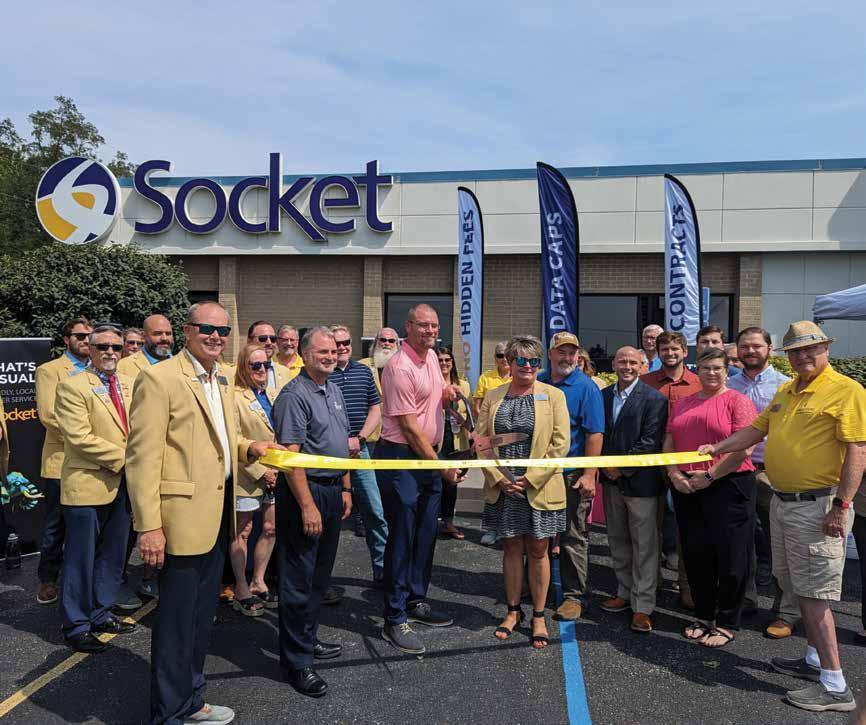
e expansion is possible due to funds Socket received as part of an ARPA Broadband Infrastructure Grant. e focus of
the grant program is to provide resources to help providers, communities, counties, and regions invest in building broadband infrastructure in unserved and underserved areas of the state.
“Socket is committed to our investment in constructing critical internet infrastructure in Boone County,” said Socket President and COO Carson Co man. “Our ber network will allow customers to enjoy reliable and fast internet so they can successfully work, go to school, and even visit with doctors via telemedicine appointments.”
Socket started providing ber connections to customers in 2011 and currently provides ber connections to more than 20,000 customer locations.
Columbia College will launch more than 20 new academic programs online this fall as part of its commitment to preparing students to meet the needs of tomorrow’s workforce. From Global Studies to Supply Chain Management and Logistics, the new programs, which are open for enrollment now, include two master’s degrees, ve bachelor’s degrees, one associate degree, and 12 certi cates, many of which are stackable.
Four existing bachelor’s degrees o ered in-seat will also be added to the college’s online o erings, and three new emphasis areas will enhance its Master of Business Administration program.
“ e creation of these programs is responsive to what students need to succeed in their future endeavors,” says Dr. Piyusha Singh, provost and senior vice president for Academic A airs. “We believe these o erings re ect what employers are looking for when hiring the next generation of leaders.”
e programs will be housed within CC’s three recently reorganized schools starting in the 2023-24 academic year: School of Public Service, Dr. Sandra Hamar, dean; School of Arts & Sciences, Dr. Jennifer Jewell, dean; Robert W. Plaster School of Business, Jonathon Moberly, J.D., dean.
exhibit through April 2024. e exhibit shares the stories of people in the community who have served in the armed forces overseas along with rst responders who served on the frontlines.
Founded in 1924, the Boone County Historical Society collects, preserves, and exhibits historic artifacts, records, and artwork of Boone County residents. Its “Heroes Among Us” exhibit is a way to celebrate not only military abroad but also friends and neighbors who worked every day to keep the community safe. e display presents artifacts tracing the evolution of local re and police protection along with artifacts from the Spanish American War, Vietnam War, and more.
e exhibit also includes a room called “On My Honor.” is display shows how volunteers are leading the next generation of heroes by highlighting the stories of dedicated scouts and exploring the di erent ways kids can get involved and learn new leadership skills.
of all rated hospitals receiving a designation of “high performing.” Boone Health ranked “high performing” in abdominal aortic aneurysm repair, aortic valve surgery, back surgery, colon cancer surgery, heart attack, heart bypass surgery, heart failure, hip replacement, knee replacement, leukemia, lymphoma, myeloma, prostate cancer surgery, and stroke.
e Columbia Public Schools Foundation (CPSF) announced New Educator Grants for educators new to the Columbia Public Schools, surprising each with a $100 gift card at the CPS New Educator Breakfast held in August.
Names Boone Health
Among Best Hospitals for 2023-2024
Boone Health has been named the No. 1 hospital in mid-Missouri and the No. 7 hospital in the state of Missouri by U.S. News & World Report in the publication’s 2023-2024 Best Hospitals report.

Each new educator received a $100 gift card to use as they need to help establish their classroom. In total, the Foundation is expected to give out about 300 gift cards to new educators, or about $30,000. e Foundation’s board members were on hand at the breakfast to distribute the gift cards to the new educators.
e Boone County Historical Society, a nonpro t organization, owns and operates the Boone County History & Culture Center which is currently showcasing its “Heroes Among Us”
Boone has held the top spot in mid-Missouri since 2015. U.S. News evaluated more than 4,500 hospitals across 15 specialties and 21 procedures and conditions; only 12 percent of evaluated hospitals earned a Best Hospitals ranking. Hospitals awarded a “Best” designation excelled at factors such as clinical outcomes, level of nursing care, and patient experience.
Hospitals are ranked from 1 to 50 in each specialty, with only 10 percent
“ e Foundation’s board is so excited to support this new program,” said Katie Harris, executive director of CPSF. “It’s the rst year in our more than 25-year history that we’ve done something like this. We wanted to show new teachers that we know how much they end up spending out of their own pockets, and we support and appreciate them as they’re setting up their classrooms and starting their teaching careers with the best school district in the state.”
anks to the Foundation’s partnership with Central Bank of Boone County, the gift cards have zero fees. e new educators will receive the full $100 amount on their cards. CBT
PRUDENT BUSINESS PEOPLE depend on key performance indicators to gauge the success of their organizations. If they observe the continued erosion of these published metrics, some tougher questions are necessary.
What is leading to this underperformance? Have there been signi cant changes in market conditions or customer needs? Do frontline sta have the resources they need to do the job? How is internal communication? Should we supplement
our service o erings to meet customers where they are?
Your manager's group and labor leaders claim if they just had more money for sta raises it’d get better, while others recommend outsourcing underperforming units.
You ask the frontline sta and get sheepish canned responses, until in friendly conversations, curious clues emerge. en maybe o site, outside the public eye, you get the real story that those in the trenches are dying to tell somebody, anybody.
Such is the situation of public K-12 education in Columbia today.
Of three key performance indicators for the Columbia Public School district, one looks good: they have a 90 percent graduation rate.
Another has sagged. Only two-thirds of students log good attendance, de ned as 90 percent or better (missing an average of no more than 1 day every two weeks).

e third is plain abysmal. Only about 40 percent of “scholars” test pro cient in math or reading.
So the district hands out a lot of diplomas, but fewer kids are regularly showing up to class, and standardized test scores do not indicate learning is actually occurring.
Any reasonable observer would conclude something is up. Concerned citizens might fall back on their own assumptions or ideologies — but good managers nd ways to dig deeper.
School o cials are publicly o ering us more clues than ever on the attendance quandary. Students don’t want to come to school, and their parents or guardians aren’t getting them there. Students got used to remote learning during the pandemic, so they got out of the habit of valuing in-person school.
More parents are less hesitant about pulling their kids out for family vacations when school is in session. A family member of mine described a classmate whose family stayed home over winter break, but purposefully scheduled a trip out of town for the week school was back in session.
I asked a local business owner about this key performance indicator and he o ered his concern that if a young person isn’t showing up for school, they would be less likely to show up for work as an adult, too. Sure enough, there’s a national trend of hiring managers pulling their hair out over job candidates who “go ghost” — where some new hires don't even show up for their rst day.

How should we rate the data? at only about 40 percent of CPS students test procient in math or English is an F grade, with the state now ranking CPS as a whole just a hair above “marginally accredited.” is trend predates the pandemic and the recent dropo in attendance.
One hint that keeps getting mentioned is the rate of poverty, as measured by about 40 percent of CPS students qualifying for free and reduced lunch.
e more o ine conversations I have with teachers, parents, school administrators, and nonpro t charity leaders, the picture that emerges is there are more kids than ever who are not prepared to learn when they start the school day. ey didn’t get a square meal or a good night’s sleep, let alone help with their homework or even a hug.
I interviewed CPS superintendent of schools Dr. Yearwood, who in describing the ongoing life situation of many “scholars,” used the word “trauma” — more than once. What is a trained teacher who is ready and willing to provide learning services supposed to do with a student who is hungry, tired, preoccupied, or unruly?
More and more I hear hints that more kids these days do not give a lick about school because they come from households where learning is not valued. It seems to be a trend spanning generations now, and across social demographics.
Delivery of basic services into the schools is one response, from sending Buddy Packs of food home on weekends, or how CPS just partnered with a new health clinic at Field School to provide eyeglasses and sports physicals to kids who aren’t getting them otherwise.

Dr. Yearwood o ered another hint when I asked at a public forum about test scores: that the test isn’t the best, and — pause — they can’t force kids to try their best when taking it.
My daughter, a high school freshman, con rmed this is common knowledge in her world: students are informed that the state MAP test doesn’t count toward their grades. Some kids don’t even try and just ll in random answers.
Wait — how are we supposed to know where we stand without an accurate mea-
sure of student learning? Of all the things debated in our State Capitol, how about instead we work to develop a test that actually measures learning that has occurred?
Dr. Yearwood has o ered another clue recently: that instead of criticizing the school district, come help them. I take that as a call for all hands on deck.
e Partners in Education program is positioned to step up. Students could use volunteers as reading buddies. ere is no limit on the number of mentors that are needed.
For yours truly, I keep intersecting with colleagues involved with Junior Achievement, which matches up business professionals to teach supplemental business courses in the schools. eir catalog has a middle school economics curriculum ready to go. Gee, I could do that.
We all have professional skills and life experience that many kids need to experience. What pulls at your heartstrings? Find your opportunity there. CBT
Dr. Yearwood has offered another clue recently: that instead of criticizing the school district, come help them. I take that as a call for all hands on deck.
For 40 years, the Partners in Education program has been enriching the lives of students and the community at large.
 BY EMMI WEINER
BY EMMI WEINER
Four decades ago, Columbia Public Schools invited local businesses into schools to help teach children life skills, introduce career opportunities, and build community. e program was pioneered by Jolene Schulz, former director of communication and school/community programs with Columbia Public Schools, as part of a Reagan-era education initiative.
e program began nationally as a result of a presentation to to then President Ronald Reagan, by Barbara Russell — an educator from Nashville, Tennessee — Shulz says. Russell created “adopt a school” and pitched it to Reagan, who reportedly thought the concept was “absolutely wonderful” for getting the business community involved in Nashville schools. Schulz traveled to Washington, D.C., to see Russell at a conference.
When Schulz returned from the conference, she was geared up to start the program in Columbia. However, she was concerned that Columbia businesses might not have the same resources as businesses in urban hubs.
“We don’t have all these big businesses in Columbia that all the big cities have like Nashville, Dallas, or San Diego,” Schulz says, recalling the initial challenges facing the program. “And [former superintendent of schools] Dr. ompson looked at me and he said, ‘Jolene, make it work.’”
Schulz and her team decided to take a di erent approach. She didn’t think schools wanted to be adopted or that businesses wanted to adopt schools. She wanted to create a mutually bene cial program that helped not only the students but the businesses and the community, too.


“We wanted both the schools and the businesses to feel very comfortable with what they were doing,” she explains.
To kick o the program, Columbia Public Schools invited Russell to Columbia to talk about the success she was seeing in Nashville. e need in Nashville was great, as Russell explained, and businesses were helping with everything from repainting classrooms to even teaching during a teacher shortage.
“When Barbara Russell came to Columbia, we invited 15 businesses that we thought were the movers and shakers in Columbia to attend lunch,” Schulz adds. Russell discussed the Nashville program, what it
was like, and how it was bene tting the schools and the communities.
Of the 15 businesses invited to the Columbia presentation, 11 signed up for the program.

Partners in Education aims to show students the multitude of options after K-12 education ends. Schulz says the program introduces children to the many opportunities available to them after school.

“When I was growing up, I could be a secretary, a nurse, or a teacher, and that was it,” she beamed. “ e goal is to expose kids to the fact that they can be a scientist or they can be a construction worker. ey can be whatever they want to be if they know what’s out there.”
e idea is to get as many di erent types of businesses involved and distributed equitably to the di erent schools in the district so that students are exposed to a variety of businesses during their time in CPS.
“We tried to make sure that the kids had an opportunity to be with di erent businesses from elementary school all the way through high school,” Schulz says. “So they are exposed to as many as 10 di erent businesses by the time they graduate”
e businesses share resources with the schools to enrich the curriculum, introduce students to life skills, and provide human capital to the schools.
“We asked for a handshake instead of a handout. We wanted human resources,” Schulz recalls. “ ey weren’t having to write a check. We thought that we could foster a good understanding between the public school system and the business community.”
Partners in Education is celebrating 40 years this year and roughly 250 businesses are involved with the program, some of which have been involved for decades. Each partnership is unique and allows the business to get creative with how it interacts with the schools.
e goal is to connect members of the community and share resources. Businesses come in and help children learn about the world around them. Molly Delgado, CPS
community relations manager, says some partnerships focus on academic achievement and skills, like D&H Pharmacy’s literacy week at Midway Heights Elementary.
“Each week has a special theme. In the past they’ve done ‘Wild About Reading’ and they will bring in some animal stories that coordinate along with some crafts, all while promoting literacy at Midway Heights,” Delgado enthusiastically recalls. “ en they celebrate” by providing snow cones from Kona Ice or some other treat.

Other partnerships focus on introducing children to the variety of options available to them once they graduate. For instance, Douglass High School has several downtown business partners and will host a career development event, where each of the partners sets up a booth and then works on mock interviews, resume writing, and what it means to be part of the community, Delgado explains.
Some partnerships, like Junior Achievement, provide access to all students, like the yearly trip for fth graders to BizTown in Chester eld.
“ e kids experience being the mayor, being the manager, learning about if they don’t pay their bills, or what happens if they are short-sta ed with employees,” Delgado adds. “I know a lot of kids will come back and say, ‘Oh, I was an adult today. at was really hard. But fun.’ ey come back with fun stories.”

To get involved, a business owner or leader simply has to contact Delgado. From there, the business and the school work together to come up with a unique partnership.
“It is really meant to be a true partnership. It’s not about donations. ere isn’t a cost associated with becoming a Partner in Education,” says CPS Chief Communications O cer Michelle Baumstark. “It is truly about a mutual relationship between the program and the business or organization ... It provides an opportunity for our scholars to be able to interact with people in the community. It provides an opportunity for employees from the business to be able to have a better understanding of what happens within the school building.” CBT
“We asked for a handshake instead of a handout. We thought that we could foster a good understanding between the public school system and the business community.”
Did you know that Columbia College’s Evening Campus has been around for almost 50 years? e college, founded in 1851 as Christian Female College (CFC), has a long tradition of adapting to changing times, rising to meet the community’s needs, and remaining innovative to stay ahead of its competitors.


e COVID-19 pandemic disrupted education everywhere, but the evening campus hummed along nicely as it stepped into its full technological potential. is summer, the college announced it was adding 20 new academic programs in high-demand areas chosen to address the growing national skilled worker gap, starting with the August 2023 term.
“I think COVID-19 has done a lot of damage to schools across the country,” says An-
drew Reeves, evening campus director since 2018. “I'm proud that we’re still a staple in the community and still providing the services we provide.”
CFC barely had time to get o the ground when the Civil War broke out. Despite the risk, it was the only college in town that did not miss a day of classes during the war, thanks to faculty that stayed on knowing they may not be paid.
A few decades later, CFC President Luella St. Clair became one of the rst female college presidents in the country.
e two-year, all-female college transformed into the four-year, co-ed institution of Columbia College in 1970, a cunning change that set the stage for the future. In 1973,
CC was among the rst colleges to establish a presence on military bases to serve active-duty military, veterans, and their families. Today, CC has more than 40 satellite locations in 16 states and Cuba.
In the 1970s, adult higher education took o in America; by the end of the decade, adult part-time students started to outnumber traditional 18-year-old students fresh out of high school in “night schools” across the country.
“More than three-fourths of the nation’s 2,900 colleges and universities o ered adult education programs in 1978, more than twice the number o ering them a decade before ...,” writes Bart Barnes in a 1979 Washington Post article entitled, “Adults Flocking Back to College Classrooms.”
Columbia College opened its evening campus in 1975, right in the thick of the night school trend. And having gone co-ed ve years previously meant many more students could access classes.
“So we used to be the only game in town for evening classes,” Reeves says. “I think other schools have started to become more active in the evening time. But we’ve been here for a long time and currently we serve both undergraduate and graduate students.”
Adult higher education continued to boom through the 1980s. e internet changed
the world in the 90s, and while some schools and institutions oundered to adapt, Columbia College jumped right in, recognizing the opportunity. It opened its online campus in 2000, one of the rst in the country — years ahead of other schools. In the years to come, the online campus rolled out hybrid courses, taken partially in-seat and partially online, adapting to the ever-shifting online education environment.
While the adult higher education industry constantly is changing, the type of student attending night school hasn’t: working parents who put their education on hold to raise a family; the employee who needs a degree to qualify for a promotion; and folks who want to change careers.
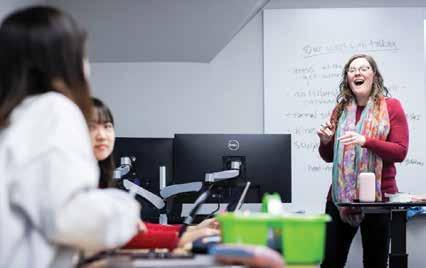
“A lot of these students are working during the day. And then they have to squeeze in completing classes when the kids go to sleep or when they have free time,” explains CC Admissions Recruiter Lisa Hussey, a 2008 CC grad. “ ey took some college, then dropped out because they started a family. And now the kids are older and they’re ready to focus on themselves. I hear that a lot.”
Hussey recruits evening campus students by recruiting their employers. Employees of companies that partner with CC receive a 15 percent tuition
discount, and some companies even o er tuition reimbursement to their employees. CC has tuition-discount partnerships with Veterans United, MFA, city of Columbia, Shelter Insurance, Lenoir Woods - Lutheran Senior Services, and more. And the discounts don’t stop with the employee.
“ e employee gets that, their spouse or domestic partner, and also their child dependents, 25 years of age and younger, would get that 15 percent discount,” Hussey explains, adding that the perk helps companies to retain their employees.


She says nursing and biology are big draws for evening campus undergrad adult students, as well as the MBA program.
“We shifted everything to make it easier for adult students to take classes,” Reeves says about evening campus during the COVID-19 pandemic. “And it’s been remarkably successful.”
CC o ers open enrollment, and with classes o ered in six eight-week sessions, students can jump in at about any time — as well as take a pause when needed, which is especially helpful for students who get deployed unexpectedly. And while some schools may charge fees for registration, printing, labs, and more, CC prides itself on its transparent
tuition schedule, which has no fees and includes the cost of textbooks.
Currently, about 1,000 students are enrolled in the evening campus. e average class size is 15 students.
When COVID-19 closed schools everywhere, CC already had 20 years of experience in o ering online education and was well-positioned to adapt. e college began o ering what Reeves calls virtual classes, in which students join a live stream of the in-seat course. And they aren’t just passively watching; streaming students can participate and interact with the instructor and other students.
“A pandemic is never something good to talk about,” Reeves says. “But with our infrastructure, we were very prepared to make that switch over [to virtual classes]. And we found out our students like to be connected with that instructor and other students. And it’s worked tremendously well. I don’t see the virtual classes really ever going away, because our students really have adapted and really like taking classes that way.”
With eyes always on the horizon, Columbia College is expanding its academic programs by more than 20 starting this August. e programs include two master’s
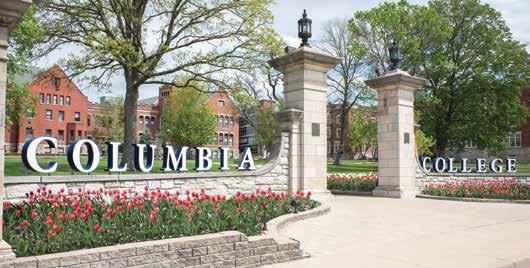

degrees, ve bachelor’s degrees, one associate degree, and 12 certi cates. Additionally, four existing in-seat bachelor’s programs will be added to online campus, and three new emphases will be added to the MBA program.
e two new master’s degrees o ered are in nance and business analytics. e new bachelor’s programs include the in-demand areas of supply chain management and logistics, global studies, Spanish language and cultures, and statistics. e certi cates range from human resources analytics and sports analytics to logistics and transportation, communication, and organizational leadership.
In a July 12, 2023, press release about the recent programs, Piyusha Singh, then the provost and senior vice president for academic a airs, said the college sought and received important feedback from various CC-connected groups and individuals throughout the process.
“We believe these o erings re ect what employers are looking for when hiring the next generation of leaders,” Singh said.
“ ere are a lot of real-world, hands-on things that we’re developing, that have been requested and shown a need for in our area,” Reeves adds. “We’re looking forward to lling that gap.” CBT
“We shifted everything to make it easier for adult students to take classes. And it’s been remarkably successful.”
ANDREW REEVESLISA HUSSEY
Belly Market and Rotisserie is a flavorful sequel for COMO appetites.

 BY LYDIA GRAVES PHOTOS BY REBECCA ALLEN PHOTOGRAPHY
BY LYDIA GRAVES PHOTOS BY REBECCA ALLEN PHOTOGRAPHY
Not all romantic comedy sequels are bad. Not going to sugar-coat it, though, a decent bit of Net ix movies in that category fail miserably. But then there are those exceptional few that rise above the rest. ey’re heartfelt and hilarious.
ey make the audience fall in love with the characters all over again.
Belly Market and Rotisserie is just like those lovable follow-ups — plot twists and all.
is narrative is driven by two Midwest-native chefs fascinated by local, thoughtfully crafted food. Although each had their own respective success in the industry — delving into culinary schools and working in big cities — it wasn’t until the two found themselves back in Missouri that things had clicked into place.
Ben Hamrah had been catering with his family business, Peachtree, on set at Blue Bell Farms one evening. Blue Bell also happened to be where Amanda Elliott worked at the time. Hamrah found himself walking past several glass-front coolers to notice deli containers labeled with green tape, all neatly organized. He had no hesitation in grabbing a few spoons, pulling all the containers out, and trying everything. rough her food, Hamrah rst met Elliot. e rest followed shortly after.
It wasn’t long before they were working together. Elliot began cooking for Peachtree Catering, rst during o seasons, but soon found herself there full time. ere was a goal present between the two to build recognition for catering businesses, proving that avor and quality was not a compromise within the platform. Once their minds were set, the business went from a
mom-and-pop-style operation to a locally sourced, high-end caterer.
e protagonists continued their journey as business partners with the opening of their restaurant, Beet Box. It was originally intended as an extension of the catering company to sell boxed meals for lunches and dinners. However, as if it were a blockbuster, it rapidly grew in popularity. After only a few years, the brick-and-mortar had built quite the audience for itself, ourishing under the spotlight.
But it wouldn’t be a rom-com without the quirky, loveable, and very unexpected interest. Amid another project, the business partners were approached by the now-former owners of Hoss’s Market and Rotisserie.
“ ey were really interested and excited for us to take it over, but they wanted to do a very quick close,” says Hamrah, “We looked at the business that they had built for almost 20 years, and it was a very successful business with a large following. A big push was the amount of catering that they did, so it was an opportunity for us to diversify.”
e name was changed to Belly Market and Rotisserie for its next role. e new purchase became a priority and a promising prospect.


Since the transfer of ownership, the response has been warm and approving. Long-standing customers of Beet Box and Peachtree seemed ecstatic to have yet another location to try new, delectable creations. A majority of Hoss’s loyal customers have been enjoying the consistencies while also anxiously anticipating what’s to come.
Still, it wasn’t all lovey-dovey. ere were a few minor complications. It was a process, as it is most times, to develop a business.
With this one, a legacy stood intact. It became a question of how much should the location remain Hoss’s, and how much should nd its path to Belly.
“To be able to be going on four years [at Beet Box] and to be successful at just making whatever it is we want to do has been a really cool opportunity. But it is very different to be taking over an almost-twenty-year-old existing business because you have a group of clientele who have relied on this place,” Hamrah explains, “So we didn’t want to immediately change everything.”
Amanda Elliott and Ben Hamrah took a deliberately strategic approach to their rst year running Belly Market and Rotisserie. ey took note of positive and negative ratings. is helped gauge the customers’ opinions as well as their own for how best to rewrite the script.
Inevitably, there were show-stopping fan-favorites — such as the star rotisserie chicken. And there were also concepts that simply didn’t make the cut. In the end, the hot case had to meet its nal curtain.

Beginning in late July 2023, Belly Market and Rotisserie debuted its up-and-
coming rotisserie chicken platters. e fall-o -the-bone, slow-roasted rotisserie chicken recipe itself has not much veered since the previous ownership, other than a few small tweaks to make it their own. In terms of the platters, there are now two options beyond the traditional chicken — Middle Eastern Style or Midwestern Style. ey’re both Belly’s way of delicious grand gestures. With the mezze platter approach, the chicken — dressed with either the pomegranate molasses, zaatar, and dried roses for a Middle Eastern Style or the traditional chicken seasoning for the Midwestern style — accompanied with enticing seasonal sides.
Speaking on behalf of the mezze sides, Elliot notes, “Instead of going what we think of with traditional coleslaw, potato salad, and baked beans, I wanted to encourage more of that seasonal approach. We’re in the height of summer. It’s the prime time to be able to enjoy these vegetables.”
In most of these movies, there’s a brief encounter where, after a good amount of time spent, a “what-if” moment makes its appearance. e viewer waits in anticipation. Although this wondering of what
could be happened o -screen, it wasn’t absent from the story. Elliot took her time with this menu, transforming it into a stunning array of tang and zest.
“I put a lot of thought into how it visually looks rst-and-foremost. I really wanted it to be playful and colorful. Aside from that, it was thinking about which vegetables are available and how we can play with them,” Elliot explains.
e takeaway? Try something new that was an unexpected favorite. Go beyond your comfort zone in an atmosphere that feels like home. It’s di cult to go wrong.
e two want guests to leave with a nourishing experience, and — as Elliot says — to be friends.
“ e regulars are the thing that warms my heart,” she re ects as Hamrah gives a shout out to regulars Paul and Mary.
Both also stress the thanks and appreciation they direct towards their sta and crew for diligently working on the nished product and helping make this punch-of- avor, locally grown, seasonal dish possible.


Hamrah expresses how exhilarating it has been in the kitchen, teaching new plates to the Belly team.
“You’re coming to a place where the product is days old. It was in the ground a few days ago,” he adds. “ at’s something we’re excited about, but also to be able to highlight it to the best of its potential in the way Amanda approaches food has been very exciting to teach.”
e happy ending of Belly is certainly a smile-and-call-to-order-pick-up worthy. e market itself has had character growth since rebranding but moving away from the hot case provided for so much fresher, farm-grown options.
Give into your stomach’s infatuation. It’s food that hits every side of the palette. It’s sweet, it’s salty, it’s sour, and it’s herbaceous. And it’s leaving the audience anxiously awaiting the third installment.
Belly Market and Rotisserie is located at 1010 Club Village Dr., in Columbia, Missouri, next to Walgreens o Forum Boulevard. CBT


The takeaway? Try something new that was an unexpected favorite. Go beyond your comfort zone in an atmosphere that feels like home. It’s difficult to go wrong.












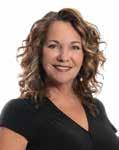



The relationship between a business and its marketing agency is a very special and important one. As their partner, an agency often has ready access to their website, data, and digital assets. We get to hear the dreams and goals of our clients and take on the mission of helping them achieve them. This can feel very vulnerable to a business owner, and they need a partner that understands that. If you are thinking of hiring a marketing firm or have a relationship with one already, here is a checklist of what is important in that relationship and should help you find and keep the right partner.
Many people decide to hire a marketing firm to make their lives easier. They want someone that understands the everchanging world of digital marketing, search engine optimization, web development, and social media. In fact, many are so excited when they do hire a firm that they immediately throw that ball into the agency’s court like a grenade only to be rarely seen again. This is an example of a bad working relationship between a small business owner and their marketing firm. A healthy relationship is based on thorough and timely communication. At COMO Marketing, this is represented by our commitment to clear project timelines and weekly progress report emails. We never want a client to wonder what we are doing to help them or what we need to be successful that week.
Your agency needs to have the heart of a teacher. At COMO Marketing, it is very important to us that our clients understand the investment they are making and the return on investment that they should be expecting and getting. We require a minimum of one hour a month to review reports and work on strategy for the next month. During these meetings, we make sure to thoroughly explain our approach and why we are using the tools that we chose.
Collaboration is mandatory for success. There’s no one size fits all approach in marketing. It’s an art form and one to be perfected in an ongoing collaboration with the client based on their strengths, ideas, assets, changing environment, and available bandwidth. The strategy presented should be a reflection of that specific client’s needs and goals and not a template made for everyone.
Reporting on progress made on the strategic plan as well as the return on investment should happen on a regular basis, ideally monthly. Reports should be easy to interpret and understand with little use of industry acronyms. Goals should
Charles Bruce is the Director of Sales for COMO Companies which owns COMO Marketing, COMO Magazine, and COMO Business Times. He received his Bachelor’s Degree in Business Administration and his MBA from the University of Dubuque. When Charles isn’t being the life of the party, he can be found climbing a large mountain. His goal is to climb the Imja Tse mountain in Nepal in December 2023.
be specifically stated along with progress towards goals.
Full Time Team
I would recommend choosing a team that has a full time staff of project managers, writers, web developers, designers, and strategists. If an agency relies on freelancers to provide services for their client, quality control and consistency in brand as well as adhering to tight timelines can be an issue. At COMO Marketing, your business is assigned its own team that is fully immersed in your brand making sure nothing is missed.
Lastly, I would recommend that you pick a locally owned marketing firm. By choosing a local firm, you are choosing someone that knows your target market, knows your competitors, and knows the uniqueness of your community. As a locally owned small business ourselves that owns COMO Marketing, COMO Magazine and COMO Business Times, few organizations know Columbia as well as we do.
If this is a hire that you plan on making, let’s chat and see if we are a good fit. Email me at Charles@comocompanies.com.

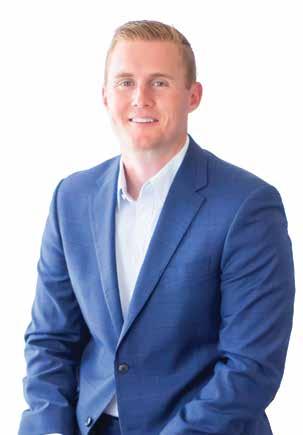 By Brad Roling broling@midambk.com
By Brad Roling broling@midambk.com
It seems like everywhere you turn, there are “Hiring” signs posted. A lot of business owners are having to raise their wages and offer better benefit packages to attract or retain employees. If you need to do the same, a Health Savings Account (HSA) can be a great asset to your employee benefit package. Also, an HSA can be an added benefit for the business as well by taking advantage of all the account has to offer.
A Health Savings Account allows the accountholder to set aside money on a pre-tax basis to pay for qualified medical expenses. These qualified medical expenses typically include deductibles, copayments, coinsurance, and some other expenses like prescriptions, vision care, and dental care. By setting money aside in an HSA, usually it allows accountholders to lower their overall health care costs.
No matter your employee’s healthcare plan, there are still out-of-pocket expenses before their deductible is met. This is especially true for high deductible plans so offering an HSA to employees with high deductible plans can be a huge benefit. Since the account is designated for healthcare related expenses, it encourages your employees to save money for these expenses, planned or unplanned.
Health Savings Accounts also offer tax advantages for both the business owner and employee. Contributions are not subject to federal income tax when they are deposited into the employee’s account. Any withdrawals made from an

HSA, if for qualifying medical expenses, are tax free as well. Depending on the nature of the HSA program your business goes with, you could potentially benefit from lower payroll taxes. Certain HSA programs don’t include employer contributions to employee HSAs in employee income, so they are not subject to federal income tax, Social Security, or Medicare tax. Please consult your tax advisor before deciding to offer or open an HSA, as they can advise you on your business’s individual situation.
Other benefits to note are that HSAs have very little administration involved. You can offer the service of setting the
Brad Roling is the Columbia Market President for Mid America Bank. Brad has more than 10 years of banking experience that he uses to help businesses in and around Columbia thrive. When he is not helping your business with its financial needs, Brad is serving the community in a variety of capacities. He is proud to serve on the Ronald McDonald House Mid-Missouri Board of Directors as Treasurer, the Columbia Chamber Foundation Board, and Beta Theta Pi Advisory Board. Brad is a proud Mizzou grad and loves cheering on the Tigers!
HSA up for your employees or they can go to the bank you choose and set it up themselves. Additionally, the funds will roll over year over year. The funds can even be saved and used for medical expenses in retirement.
If you’re looking to invest in your business and employees, offering a Health Savings Account may be right for you. The associates at Mid America Bank would love to talk more with you about our Health Savings Account program. You can also scan the QR code to visit our website for more information.

As a leader in the innovative practice of value engineering (VE), Prost Builders Inc. is positioned to discover cost savings throughout the life of a construction contract. A shining example of how VE benefitted the Columbia Public Schools – and thereby local taxpayers – is a building project at Jefferson Middle School in Columbia.
First, for a quick refresher, VE is a deliberate, disciplined methodology to look at all building systems to deliver the best possible value for initial and long-term project management. The most money can be saved, and the schedule controlled early in the design process when VE is most effectively used.
In short, VE saves time and money.
One recent example, among many, of how Prost Builders has proven the concept of VE was a major building project at Jefferson Middle School. As the general contractor, Prost saved the Columbia Public School District over $300,000 when the designed steel bar joists and metal deck system were going to delay the construction due to steel supply issues. In response to that schedule demand, Prost value-engineered a doubletee, pre-stressed concrete roof system for the new gymnasium roof to save the school three months’ time on the construction schedule –and a net construction savings of $365,000.
The school was built in 1910 and needed ADA upgrades, a new gymnasium, locker rooms for boys and girls, connecting corridors between the gym and the existing school, elevators, and stairways. The resultant VE time saving, and cost saving, was extraordinary. The gymnasium is now a tornado shelter that is connected from the top of the roof down to the foundation with 12-inch-thick masonry walls. Prost Builders successful team of construction manager, superintendent, and and trusted highly skilled subcontractors pushed the project to substantial completion on time and under budget.
It’s interesting to note that Vaughn Prost even has a personal connection to that project because he played basketball in the old Jefferson Junior High School gym when he was a student. He can attest to the fact that the brand-new gymnasium is a major improvement.
There are other examples of Prost Builders providing cost-saving ideas that resulted in decreasing the cost of the construction contract and/or shortening the construction schedule for school building projects:
• Rock Bridge Elementary School addition and renovations: Prost accelerated the construction schedule through the winter months using concrete blankets, heat and winter weather enclosures, and bulked up manpower forces saving 217 calendar days on the contract schedule.

• School of the Osage Middle School, FEMA addition and locker room: Prost Builders Inc. Value Engineered out $142,000 of the project cost without changing the project design intent. Some of the cost savings steps included raising the building pad to reduce rock excavation, more cost-efficient lighting systems and reworking the concrete ramp arrangement.
Vaughn Prost is the owner and president of Prost Builders lnc., a design/build and construction services firm located in Columbia. Vaughn has over forty years of domestic and international design and construction experience as a cost and scheduling engineer, structural engineer, owner’s construction representative, and general contractor.

(573) 635-0211 | prostbuilders.com
3305 Crawford Street
Columbia, MO 65203
There are other school project examples of how Prost Builders provided input and ideas during the design phase to result in improved air quality, reduced maintenance, and, even more importantly, reduced construction costs. Some of those steps included:
• Connecting school districts with the Federal 178 Program for cash payments to reimburse them for some of the costs of more energy efficient systems.
• Incorporating water source heat pumps, which have redundancy and a 30-year lifespan, in addition to a 30 percent federal cash payment for such heat and cooling systems.
• Improving air quality by keeping fiberglass out of the HVAC air stream, using HEPA filters that remove dust, pollen, mold, bacteria, and other airborne particles, and providing the UV lights on air handlers to kill bacteria in circulating air to school classrooms.
These successes highlight the ability of Prost Builders Inc. to effectively and efficiently deal with marketplace cost escalations and schedule changes in ways that keep quality performance as the top priority while completing all jobs, no matter how large or small.
VAUGHN PROST Owner & President

 By Alicia Cunningham AliciaC@accountingplusinc.com
By Alicia Cunningham AliciaC@accountingplusinc.com
In the business world, distinguishing between an independent contractor and an employee is crucial. Independent contractors are selfemployed individuals offering services on a contractual basis. They determine their work schedule, bear their own expenses, and often work for multiple clients.
Contrastingly, employees work directly under a company’s control, adhering to specific work hours and rules. They get a consistent wage, while the employer covers business expenses and provides employee benefits.
Misclassifying workers can have serious legal implications, including fines and lawsuits. Thus, business owners should consider these aspects:
1. Control: If the business directs how, when, and where work is done, the worker is likely an employee.
2. Financial Investment: Independent contractors usually invest in their equipment, whereas employees use resources provided by the firm.
3. Permanency: Ongoing relationships suggest an employee, while project-based work typically implies an independent contractor
4. Integration: If the worker’s services are central to the business, they’re likely an employee.
5. Independence: Independent contractors typically work for multiple clients and advertise their services.
To avoid issues, maintain clear contracts, document payment records, and seek legal counsel when unsure. Proper classification not only safeguards your business legally but also promotes an efficient work environment. Remember, knowledge is your best defense.
Alicia has 18 years of accounting experience under her belt, and she’s spent the last eight years at Accounting Plus. She started her career when she earned a business degree from Southern Illinois University at Edwardsville, and she hasn’t stopped learning since. Alicia is a certified Quickbooks ProAdvisor, and she receives a variety of technology and software continuing education opportunities at Accounting Plus, which is her favorite part of the job. Some of her favorite off-the-clock things to do include flower gardening, reading, camping, and fishing.
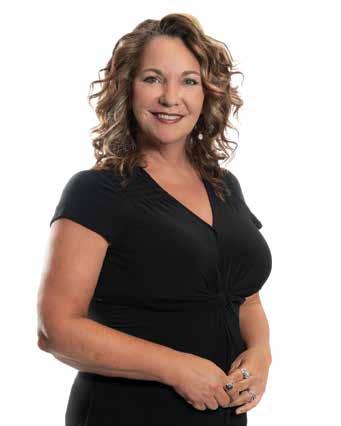
 BY MICHELLE TERHUNE | PHOTOS BY ANTHONY JINSON
BY MICHELLE TERHUNE | PHOTOS BY ANTHONY JINSON
THERE’S NO DOUBT that mid-Missouri is rich with educational opportunities. e region is also home to a wealth of small to large businesses and industries. But as is true across the country, there’s a shortage of talent with technical skills to ll job openings here.
St. Louis-based Ranken Technical College is hoping to help change that dynamic by opening a satellite campus in Ashland in 2024.

Bill Lloyd is past president of the Southern Boone Economic Development Council, and he's seen parents and high school counselors funneling students mostly to four-year colleges and universities for the past 30 years. ere has been a pervasive belief that you needed at least a bachelor’s degree to get a high-paying job.
e result? Many students didn’t pursue any education after high school while others enrolled in four-year institutions. And that left a gap in skilled workers in the trades and industry.
It's a gap you hear about anecdotally. Lloyd’s air conditioner repairman can’t nd someone who wants to take over his thriving heating, ventilation, and air conditioning business. Construction companies and automotive repair shops can’t nd employees. Industries can’t nd employees who know how to keep their equipment up and running. In response, the Southern Boone Economic Development Council, the city of Ashland, Southern Boone County Schools, and the Mid-Missouri Regional Planning Commission made a pitch to Ranken Technical College — and Ranken responded.
“We did a lot of legwork to visit a lot of industries,” Lloyd says. “At some point, early in the process, we had a meeting at the school in Ashland and I think we had about 80 people there from di erent industries from Centralia, Je City, Columbia, and Callaway County — so broad representation from mid-Missouri. at was what the Ranken president wanted to see.”
Ranken, a private nonpro t institution, has been in St. Louis for more than a century. It currently serves more than 1,800
students at its main campus, and on satellite campuses in Troy, Wentzville, and Perryville. Ashland will be its fourth satellite when it opens to students in the spring of 2024.
Ranken doesn’t look for potential campus sites to build on. Construction is a partnership with the community. e shiny new building and ve-acre campus on the east side of U.S. Highway 63 is an acknowledgment of what federal and state governments, business and industry, and local residents can do when they join forces for a common cause.
An impressive $8 million was raised to build the campus. A $4.5 million grant from the U.S. Department of Commerce’s Economic Development Administration was the linchpin, but far short of the goal.
e State of Missouri kicked in $1.5 million. e land, appraised at roughly $1 million, was donated.
“ e school superintendent was involved, but it was a community group – we didn’t even have a name, really. We were just a community group,” Lloyd recalls. “We hired a fundraising company to kickstart things. e rest we raised by going out and knocking on doors and presenting the case that we’re trying to bring technical training closer to you.”
Most of those doors were busineses and industries in the six counties served by the Mid-Missouri Regional Planning Commission, including Boone, Callaway, Cole, Cooper, Howard, and Moniteau. Companies dug into their pockets to help make the campus happen. And the Southern Boone School District is fully invested. e district will maintain the new facility and campus for the rst three years. Ranken will provide tools, equipment, instruction, and administration. After three years, Ranken assumes responsibility for it all.
Shannon Brueggemann is Ranken’s vice president for education. She says Ranken is proud of its high graduate placement rate, which doesn't happen by accident. Where the college has placed its four satellite campuses is where there is a demonstrated need for that type of skilled workforce.
“When you bring high-quality technical education to the area, industry feels more con dent they can nd the needed skilled workforce that will allow them to grow,” Brueggemann says. “ ese community leaders visited our main campus and have even met with local industry to grasp the level of technical education we provide.”
Lloyd points out that location is a far more critical factor in technical education than attending a university. Ranken students will be able to hold a full- or part-time job while also working toward a certi cate or degree. But even those students attending the Ashland campus fulltime need to be able to stay close to home. And that’s how mid-Missouri business and industry will recoup their investment in the Ashland campus.
“If I’m from Columbia and I go to St. Louis to get my training and work on an internship there, then someone there o ers me a job,” Lloyd explains. “But most people want to get back closer to home to be near family or friends. I think Ranken’s satellite campus here allows you to get the training you need and hook up with an internship with a company nearby. e prospect of having a good long-term employee improves.”
Ranken currently o ers more than 35 certi cate and degree programs. Brueggemann says the Ashland campus is slated to begin with four in the spring: Carpentry and building construction technology; industrial engineering technology; fabrication and welding technology; and, information technology. Ranken is partnering with another local area college to launch an entry-level nursing program in the fall 2024 semester. Planning assessments indicated these programs had the highest need in the area, but more programs will be o ered in the future.
Brueggemann says day and evening student enrollment estimates are 30 to 40 in the spring, growing to 40 to 50 next fall. Capacity for the Ashland campus is about 150 students. Ranken is searching for instructors which, Brueggemann says, is challenging when the targeted industries are already facing talent shortages.
“Ranken requires technical faculty to have real-world work experience,” she says. “Depending on the skills the faculty possess and their availability, we will likely start with three to four full-time faculty and one to two adjunct faculty.”
Overall administration of the campus will be handled from the St. Louis main campus. e location will have its own admission counselor and student success advisor who will assist students with scheduling, nancial aid, and communication with St. Louis, along with an assigned instructional coordinator.
Quickly creating the skilled workforce mid-Missouri needs right now? Ranken has been doing it for more than 100 years. Now, it’s doing it at the center of it all. CBT



RANKEN
314-286-3331
ranken.edu
Electric Peacock Tattoo
11 S. Fourth St. Tattoo parlor.
CALE Education & Company
2201 W. Nifong Blvd.

Morning Sun Avenue
1204 Jake Lane
Personal development company
providing workshops and mental health rst aid certi cation courses for businesses, organizations, and community members.
Elevate Salon And Spa Studios
2101 Corona Road
Lease commercial rental space to beauty industry and lifestyle professionals.
La Calle 8 Cafe
214 S. Eighth St.
Cafe / co ee shop style establishment serving hot, cold co ee, sandwiches, and others.
Atlas Autism Health
800 Cherry Street
Provider of therapy services to children diagnosed with autism.
Made On A Lathe
4969 E. Wilson Turner Rd.
Sells artistic wooden items at arts and crafts shows and markets.
Taylor’s Commercial Grounds Maintenance
801 E. Happy Hollow Rd.
Full service commercial grounds maintenance company.
Modani Care Of Missouri
303 N. Stadium Blvd.
Home health care agency.
Gold Seal Approved Management Services, LLC
2801 W. Broadway
Mobile and online notary services, background screening services, weddings, HR consulting services.
EmpowerMe Wellness
109 N. Keene St. Outpatient therapy services (physical, occupational, and speech).
Access Sign Language LLC
2103 Southwood Drive ASL interpreting service.
Columbia Mold Inspections LLC
2869 E. Alfalfa Dr. Provide mold inspections for homes and businesses.

Care With Love, LLC
2208 Blu Pointe Drive
Provides professional consulting services related to business development and community engagement.
Missouri Brinery
14 E. Business Loop 70 Small Farm Systems, LLC. Missouri brinery, making pickles at CoMo Cooks kitchen.
Dog Wild
609 Florence Avenue
Pop up events, retail, eventual brick and mortar store w/ bar.
Sweet Tees And More LLC
1809 Vandiver Drive
Selling t-shirts tumblers and mugs. CBT
Restaurants are less crowded, parking spots are more plentiful, and the tra c is lighter. But I love Columbia when college is in session, and not just because it’s easier to nd a babysitter. As residents of COMO, we’re incredibly lucky to have Mizzou — Missouri’s agship university — Columbia College, Stephens College, Central Methodist University, and Moberly Area Community College in our town, providing an incredible education to more than 35,000 students each year.
ese students live in our community, work in our local businesses, spend their money, and generally make this a more interesting and exciting place to live. And the impact is noticeable beyond the current student population. Columbia proudly boasts that 53.8 percent of people 25 years and older living here hold a bachelor’s degree or higher. ( e national average sits below 35 percent.) is impacts everything from the types of businesses
that want to locate here to the kinds of entertainment the area attracts. It impacts everyone who lives here, not just alumni of these incredible institutions.
Unfortunately, not everyone sees this positive impact, and our colleges and universities are facing an uphill battle. A recent Gallup poll found that Americans’ con dence in higher education has decreased substantially in less than a decade. In 2015, 57 percent of U.S. adults responded that they have “a great deal” or “quite a lot” of con dence in higher education. Today that number has fallen to 36 percent. Perhaps even more concerning is the increase in those with “very little” con dence; it was just 9 percent eight years ago and is up to 22 percent today.
Why the dramatic change in public opinion? It could be the increased cost of attendance and the student loan crisis. Or maybe it’s the college admissions scandals of the super-rich or the viral stories of college dropouts becoming billion-

aires. ese stories and others like them seem to have converged into a narrative that higher education is too expensive and not worth it for many people.
Despite these challenges and many more, Columbia’s colleges and universities continue to meet the needs of students and the region’s economy. ey’ve survived a pandemic and responded to changes in technology, meeting students where they are with di erent delivery methods. All while working hard to keep college a ordable and responsive to local workforce needs.
It’s important to ask questions about the value of a college degree, but the fact remains that education beyond high school is still the di erence-maker for most Americans. According to a 2021 Forbes article by former Missouri State University President Dr. Mike Nietzel, adults with a bachelor’s degree have lifetime earnings of $1.2 million more than those with only a high school diploma. For those who earn an associate degree from a community college, it’s a $400,000 increase in lifetime earnings.

at seems like a pretty good value, especially for the thousands of Missourians who use the A+ Scholarship to do so for free.
Often overlooked, community colleges are accessible and a ordable higher education institutions that provide tremendous opportunities for individuals to gain knowledge, acquire skills, and establish a pathway for further education. Short-term training and specialized courses taught at community colleges open the door to signi cant workforce opportunities. Considering the rapid pace of change in business and the workforce, we know that today’s students need skill sets and critical thinking abilities that will prepare them for careers we can’t even conceive of today.
As we enter a new academic year, I hope you’ll join me in ercely advocating for the higher education institutions in Columbia and beyond. ey need your support now more than ever. CBT
 BY BRIAN TOOHEY
BY BRIAN TOOHEY
LAST MONTH, GOVERNOR MIKE PARSON signed Senate Bill 190 into law. is new law could freeze property tax rates for residents ages 65 and older and has created many questions for taxing entities. e bill received support from both Missouri Democrats and Republicans because it also eliminates state income tax on Social Security bene ts in 2024 for some. Each county will still have to approve the property tax freeze before it goes into e ect.
O ering a property tax freeze for seniors is a great idea politically, especially just before an election year. It’s also a great idea to help seniors living on a xed income receive property tax relief since property values have soared in the last few years because of a lack of housing inventory levels. However, most baby boomers, getting ready to retire or already retired, don’t need the tax break that could last 30 years or more, and they are the age group pushing up real estate prices.
Counties, municipalities, school districts, and other entities would be better served if the state expanded the property tax credit already available to seniors and disabled residents rather than give the wealthiest generation another tax cut.
Millennials have reached the “peak” homebuying age and, since 2014, made up a majority of the homebuying market until a ordability and higher mortgage rates pushed them out. en baby boomers, whose overall wealth is $73 trillion compared to millennials — $9 trillion — become the largest segment of homebuyers. Boomers have had the opportunity to gain wealth through homeownership appreciation, and some were lucky enough to collect massive sums of inheritance.
Now, boomers are downsizing as they enter retirement and, in doing so, are competing to buy houses against millennials trying to buy their rst or second-time home. Millennials now face com-

petition from boomers who can buy with cash or nance a smaller portion of their purchases, negating a doubling of mortgage rates. A buyer paying cash has a huge advantage when a seller is considering o ers, especially in a multi-o er situation. e fewer hoops a buyer must go through to get to the closing table, the better through the eyes of a seller.
For several years, Missouri has provided a property tax credit claim for seniors and disabled individuals. Renters making less than $29,000 can receive up to $750, and $1,100 for those who occupy their home and make less than $30,000 ($34,000 if ling jointly). With an $8 billion surplus, the state could’ve easily extended the income limits and tax credit amounts to provide tax relief to seniors without providing a tax cut to those who don’t need it.
No one likes opening their property tax bill in mid-November and paying a huge bill before the end of the year. However, property taxes are an essential source of revenue for local entities. Proper funding, especially for schools, helps maintain property values, and without enough revenue, those entities will decline, and so could property values for the rest of us. If a property tax freeze is approved, the rest of us will end up picking up the tab through increases on other taxes, and that can be regressive — especially for seniors on a xed income. CBT

QUOTE YOU LIVE BY:
“How do you go from where you are to where you want to be? I think you have to have an enthusiasm for life. You have to have a dream, a goal, and you have to be willing to work for it.”
— JIMMY VALVANO
COMPANY/ORGANIZATION: Columbia College
JOB DESCRIPTION: Develop and implement a strategic vision and plan for the Robert W. Plaster School of Business.
PROFESSIONAL BACKGROUND: I spent ve years in the sports business industry representing professional football and soccer players. I then moved into higher education where I’ve been teaching for 16 years and serving in administrative leadership roles for the past nine. In addition to higher education, I have coached high school football for seven of the past 10 years.
HOMETOWN: Carbondale, Illinois
HOW LONG YOU HAVE LIVED IN COLUMBIA: Two months
FAVORITE VOLUNTEER/COMMUNITY
ACTIVITY: Coaching high school football
FAVORITE RECENT PROJECT: I am meeting one-on-one with each of my team members in the Robert W. Plaster School of Business. I enjoy learning about their history, passion, and what they appreciate about Columbia College.
YOU ADMIRE AND WHY: While I’ve only been in town for seven weeks as of today, I’ve had the pleasure of being at several lunches and events with Dr. David Russell, president of Columbia College. His story of how he ended up in this role, his approach to leadership, and his ability to have authentic conversations with individuals across all walks of life are collectively inspiring.
WHY YOU ARE PASSIONATE ABOUT YOUR JOB: e people and the opportunity. I am blessed to have a great team of faculty and sta who have a passion for helping students and a passion for Columbia College. ey make it exciting to serve them as a leader. e opportunity to then work with that team
on a shared vision and strategic plan for the Robert W. Plaster School of Business is invigorating.
WHY YOU ARE PASSIONATE ABOUT YOUR COMPANY: e plan, the con dence, and the people:
1. e strategic plan for Columbia College, particularly the commitment to diversity, is what led me to submit my application last December;
2. I feel like I am trusted and that there is con dence in me by the leadership at Columbia College; and
3. Every person I have met on campus — and I’ve met a lot of people over the past seven weeks — has been kind, attentive, and encouraging. If an organization has a plan you buy into, you feel valued and trusted by leadership, and fellow employees across all departments in that organization consistently show kindness and encouragement, it’s very di cult not to have a great passion for that organization and be excited to come to work every day.
IF YOU WEREN’T DOING THIS FOR A LIVING, YOU WOULD: Pursue a head football coach role at a high school where the team has struggled in the past and then attempt to “turn the program around” by changing the culture, working together to develop and execute a strategy that matches the culture, and move forward together.
WHAT PEOPLE SHOULD KNOW ABOUT YOUR PROFESSION: Higher education, in my opinion, is one of the most competitive industries in the world. e amount of choices that high school seniors, transfer students, and adult students have for institutions to pursue their associate, bachelor’s, or graduate degrees is unbelievable. Higher education institutions must have a compelling story that shows why they are di erent and valuable. You must ensure that your story is told to the right people using the right channels and that you meet potential students’ constantly evolving needs. is work never really stops.
THE NEXT CHALLENGE FACING YOUR INDUSTRY: Arti cial intelligence, particularly Chat GPT. Higher education institutions must gure out how it can be incorporated as a learning tool in classrooms while also ensuring that students are utilizing their own thoughts and research.
YOUR NEXT PROFESSIONAL GOAL: Complete a new vision and strategic plan for the Robert W. Plaster School of Business and begin implementing new initiatives.
BIGGEST LESSON LEARNED IN BUSINESS: Invest the time to develop a comprehensive business plan for new ideas.
HOW YOU WANT TO IMPACT THE COLUMBIA COMMUNITY: I want the Robert W. Plaster School of Business to be a destination for all students to study business and a resource to help local small businesses, nonpro ts, and entrepreneurs grow and succeed.
GREATEST STRENGTH: My ability to listen and connect with others.
GREATEST WEAKNESS: I’ve been known to have a hard time saying “no” to new projects.
WHAT YOU DO FOR FUN: I enjoy spending time with my family and our pets.
FAMILY: My wife, Dr. Jennifer Fruend, is a faculty member in the School of Natural Resources at the University of Missouri starting on Aug. 1. We have two daughters, Adeline and Eloisa, who will be starting high school and fourth grade, respectively, in the fall.
FAVORITE PLACE IN COLUMBIA:
Shakespeare’s
ACCOMPLISHMENT YOU ARE MOST PROUD OF: Marrying my lovely wife and having two phenomenal daughters.
MOST PEOPLE DON’T KNOW THAT YOU: are a fantastic beatboxer. CBT
 BY TAYLOR AMBRA | PHOTOS BY CHRIS PADGETT
BY TAYLOR AMBRA | PHOTOS BY CHRIS PADGETT
AS A MECHANICAL contracting company, QuesTec Mechanical aims to provide competitive and e ective services to the Missouri region while providing ample opportunities for growth for its employees. Scott Boyd founded the Columbia-based company in 1996 with the simple idea of creating a company that would withstand the existing competition when it came to providing plumbing and HVAC services, designs, and installations.
After a few years in the business, Boyd realized his passion was to provide experiences and opportunities for everybody in his company to succeed. Jane Moore, the director of human resources and workforce development, noted that what started as a simple operation has grown into a successful and long-lasting company of over 300 employees. e company now uses cutting-edge technology embedded into its signature process to ensure quality and e ciency with each job.
e company still values the principles that it has had since the beginning: innovative, cutting-edge, high-quality services. With roots in Columbia, the company can now be found in Columbia, Kansas City, and St. Louis as well as Louisville, Kentucky, and Springdale, Arkansas.
QuesTec o ers a unique apprenticeship program that provides education and on-the-job training for individuals interested in becoming skilled journeymen. Classes are o ered in St. Louis, Kansas City, and Columbia. During the four-year program, apprentices participate in over 570 hours of classroom time and 8,000 hours of training with QuesTec’s experienced journeymen, who mentor apprentices until graduation. e only requirement to join the program is to be 18 or older with a high school diploma or
GED, and a passion for mechanical contracting.
Moore says that apprentices who graduate from the program are recognized as experienced journeymen, “and we assist them in getting their o cial journeyman plumbing license in whatever county, city, or state they are working.” She adds that a bene t of the program is that by training the skilled tradesmen, QuesTec is creating a “consistent and reliable pipeline to create our own licensed professionals,” which ends up bene ting the communities involved.
Matthew Chick is the vice president of eld operations and the primary instructor for apprenticeship classes. He brings a unique perspective to the table. Chick was a member of the rst graduating apprenticeship class in 1999 and has had a front-row seat to witness the program’s extensive growth.
“ e most ful lling aspect of transitioning from a graduate to an instructor was being able to utilize my knowledge and experience as a foreman in the eld,” he explains. “ is allowed me to further enhance my knowledge and pass it on to others when I took on the teaching role in 2013.”
What once used to be a small class of three to ve apprentices has grown into four classes of 10 to 15 people each. QuesTec’s goal is to bring a new class of apprentices each year in the spring or summer. Moore adds that while the company is not always reviewing applications for the program, it is always receiving applications to be considered for the upcoming year whether it be online applications or paper applications lled out in its o ces.
“Changing people’s lives and emphasizing that learning a trade is a career move, not just a job, brings me great satisfaction,” Chick says.
QuesTec recognizes the importance of creating a skilled workforce through the apprentice education and training program, without requiring a college degree. e program is free of charge for the apprentices and allows them to join the team as full-time employees with bene ts.



“If you enjoy working with your hands, aspire to pursue a career in the trades, and desire the opportunity to learn valuable skills without incurring debt, then QuesTec’s program is the ideal choice,” Chick adds.
Moore says the program is registered with the U.S. Department of Labor, which sets standards for the program, and the curriculum comes from the National Center for Construction Education and Research.
She adds, “We o er a holistic education adding in adjacent curriculum such as HVAC, welding, and pipe tting, which adds value by giving more context for how all building systems ultimately work together.”
Moore also notes that the training includes “human development content” — soft skills such as nancial wellness, leadership skills, decision-making, reliability and accountability, communication skills, con ict resolution, stress management, and more to ensure the apprentices are not only ready for the job they will be doing everyday but for the added pressures that often occur throughout any career.
As he looks toward the future, Chick says he aspires to pass on his knowledge of the trades to others, “ensuring we have a skilled workforce capable of contributing to the construction of Columbia.” CBT
1390 E Boone Industrial Dr, 573-875-0260
questec.us

CPS
BY LAUREN SABLE FREIMAN
 invests in attracting and retaining staff.
invests in attracting and retaining staff.

and for Columbia Public Schools, the fth largest school district in the state of Missouri, the number of people who help educate the approximately 18,800 students in pre-kindergarten through high school is large.
With nearly 3,000 certi ed teachers, classroom support, operations, and administrative sta in 21 elementary schools, seven middle schools, four high schools, an early childhood education program, and the Columbia Area Career Center, the district is fortunate to have escaped the teacher shortages that many other districts around the country have experienced.
“Schools are a re ection of their community,” says Michelle Baumstark, chief communications o cer for Columbia Public Schools. “Columbia Public Schools is a re ection of the Columbia community. When attracting people to come to Columbia Public Schools and Columbia, the quality of the community is a big selling point.”
Each year, the district hires around 200 new teachers, which is a standard trend for same-sized districts around the country. During the spring and summer months, Baumstark says the district hires every day. Some open positions, however, have proven harder to ll, a reality that the district acknowledges, and is addressing.
“We do have challenges lling harder-to- nd positions, such as specialty areas like foreign languages and many of our critical hourly positions including classroom aides, paraprofessionals, custodial, and nutrition services,” Baumstark explains. “We’ve set some goals related to continued recruitment and retention of employees as part of the district’s new ve-year strategic plan. We’ve also implemented some unique strategies to ll some of our harder-to- ll positions. e Board of
Education has also invested in the improvement of hourly wages for harderto- ll positions, including paraprofessionals, and increases to the salaries for teachers and employees on salary schedules.”
Public school districts, by law, are not able to o er bonuses or monetary incentives, but CPS seeks to remain attractive by providing competitive salaries and wages, creating positive environments, and o ering high-quality professional development opportunities and opportunities for advancement.
“In CPS, we also provide a lot of resources and sta ng to support our employees,” Baumstark says. Where other districts may choose to forgo lling or creating needed support positions to help teachers and students excel in the classroom, she says CPS “has chosen to invest in providing those resource positions,” adding, “Again, the district is about people.”
Close to 80 percent of CPS’ budget is for people, and certi ed employees in CPS, like other districts, are paid based on established salary schedules. In 2023, the newly legislated state minimum is $38,000, but Baumstark says rst-year CPS teachers earn more than the base salary set by the state and many other districts across the state.
A rst-year teacher in CPS starts at $40,900, she says, noting that each year teachers and others move up on the salary schedule based on another year of experience, and they also move if they achieve additional levels of education. e budget for the 2023-24 school year includes an additional investment of $6.43 million for increases in compensation for all employee groups.
Teachers received an average increase of 3.46 percent, not including
21 ELEMENTARY SCHOOLS
7 MIDDLE SCHOOLS
4 HIGH SCHOOLS
1 EARLY CHILDHOOD EDUCATION PROGRAM
1 COLUMBIA AREA CAREER CENTER NEARLY 3,000 CERTIFIED TEACHERS
educational credit earned. e remaining amount is divided among 26 additional employee groups that include both salaried and hourly sta across the district.
In addition to competitive pay, CPS also o ers a comprehensive bene ts package. Medical, dental, and life insurance premiums are 100 percent paid by the district for employees working 35 hours or more per week, Baumstark says.
e district also o ers coverage for dependents and voluntary enrollment plans like vision and disability with premiums paid by the employee.


Employers across the community were challenged to ll hourly positions before COVID, and the challenge has become even greater in the post-pandemic era. Like other employers in the community, CPS continues to struggle as it seeks to hire hourly nutrition services, custodial, and facilities sta , Baumstark adds.
Bus drivers are also in demand. In addition to hiring drivers to transport students to and from school as required by law, drivers are also necessary for eld trips, athletics, and other activities for students. CPS contracts with Student Transportation of America for drivers, and Baumstark says STA faces a signicant shortage of drivers in Columbia and across the country.
She says Student Transportation of America has also increased wages and offers training and exibility. Starting pay is $22 per hour “and many drivers earn more,” she says. e nature of the position means that STA, even pre-COVID, is always hiring.
e district also contracts with EduSta for substitute teachers, and similar to STA, Baumstark says EduSta is continuously hiring and working with individuals to get them sub-certi ed.
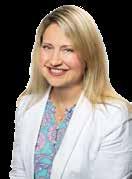
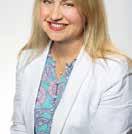
“We’ve set some goals related to continued recruitment and retention of employees as part of the district’s new five-year strategic plan.
The Board of Education has also invested in the improvement of hourly wages for harder-to-fill positions, including paraprofessionals, and increases to the salaries for teachers and employees on salary schedules ...”
— MICHELLE BAUMSTARK
e Missouri Department of Elementary and Secondary Education (DESE) has provided some relief in the certi cation processes to help school districts and sta ng companies be able to increase the substitute pools more easily, Baumstark says. Most recently, an initiative by the state to allow retirees to come back and substitute was put into place.

“Previously, retirement system rules would not have allowed this to happen,” she adds.
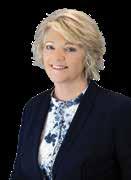
Daily pay rates have also increased for substitute teachers. Base pay in CPS is $100 per day, but many substitutes earn more with experience and longevity in the position.

In addition to creating an environment where education professionals want to work, Columbia Public Schools has also partnered with several area colleges and universities to o er CoMoEd — formerly Grow Your Own — a pipeline program for educators.
Dr. Sandra Hamar, dean of the School of Public Service at Columbia College, explains how CoMoEd works.
“ e program starts when students are in eighth grade, and they apply to be part of the program,” Hamar says. “We work with mentors at the CPS level to make sure this is a path students want to take, and as they graduate high school they start picking which partner school they want to attend. It’s a collaborative e ort.”
Columbia College accepts one to two students into the CoMoEd program per year, and the comprehensive support system includes a full scholarship for books, tuition, and housing.
“Students feel very supported through their college career here,” Hamar says. “We are in communication with CPS because they are committed to growing these students. We eliminate the nancial burdens and make sure the student is steeped in teaching with good mentoring. ey have solid support from both sides.”
In addition to classes at Columbia College, Hamar says that CoMoEd students can even take a college course in a CPS building, then apply those skills in a classroom full of elementary students.
“If our college students want to be an elementary teacher, rather than teaching at our college campus, then doing a eld placement, we teach our course on how to teach reading at an elementary school, then our students work with elementary students to apply those skills,” she adds.
Students in the CoMoEd program are required to teach in CPS for a period of time following graduation, and as the students have gone through the district themselves, and spent time teaching in the district, it’s a natural transition.
“ ere are so many bene ts of our partnership with CPS,” Hamar points out. “We have many ways to partner with CPS that make these students very comfortable with the school district from day one.
ey get very comfortable, they know a lot of the teachers already.”
She continues, “When we launch you into your rst job, the learning curve is a rocket ship, but with CoMoEd students, launching into their career is a gentle takeo , a gentle lift to get up to altitude.”
Columbia College has produced four CoMoEd graduates since 2021, and three more students are currently in the pipeline.
“I can see the number growing if we have demand and resources to fund those students,” Hamar says. “Our education department is committed to getting as many high-quality teachers into the workforce. I don’t know anything more ful lling than educating a student so they can become what they are meant to be.” CBT

“Our education department is commi ed to ge ing as many high-quali teachers into the workforce. I don’t know anything more fulfilling than educating a student so they can become what they are meant to be.”
— DR. SANDRA HAMAR
DOWNTOWN’S SKYSCAPE CONTINUES to be dominated by the cranes and equipment hovering over the Tenth and Broadway Apartments, a $7.8 million, sixstory mixed use building that is replacing the former U.S. Bank building at 1001 E. Broadway.

e new structure will have retail space on the rst oor and ve oors of apartments above it. e property is owned by Discovery Development LLC. Construction is under the direction of Central States Construction. e building will also have covered parking and 65 one-bedroom apartments.
A commercial multi-family building permit for the 53,118-square-foot project was issued in October 2022.
e old U.S. Bank building was demolished last fall to make way for the new structure. e city’s planning department listed the project as 69 percent completed as of Aug. 7.
Looking at the overall building permit picture, the city issued 223 permits in July with a valuation of $12,698,032. e bulk of the permits were for reroo ng projects (180 permits with a valuation of $4.69 million).
ere were 17 single-family residential construction permits issued with a valuation of $6.17 million. at compares to 14 single-family residential construction permits issued in June (a valuation of $7.68 million) and 14 such permits issued in July 2022 at a valuation of $4.78 million.
Other major projects already receiving permits and/or under construction include:
Spartan Pointe consists of two, identical 24-unit, three-story apartment complexes at 2104 and 2100 Battle Avenue near Battle Elementary School. Both apartment complexes will be 29,169square-feet. e city planning department placed a valuation of $4.44 million on each for a combined $8.8 million.
ose commercial multi-family building permits were issued on March 14, 2023. e property owner is Spartan Pointe, L.P. e general contractor is Fairway Development.
e fees for the permit, sewer connection, and other required costs — paid by the developer — totaled $48,764.
e clinic is being accommodated with a 16,000-square-foot, $755,360 commercial building alteration at 4230 Philips Farm Road, Suite 201. e project is an interior tenant buildout of a second oor, two-story building leased by the University of Missouri to serve as a dermatology clinic.
e building permit was issued in April 2013. e property owner is Discovery Development LLC and general contractors for the project are Sircal Contracting Inc. and Troy Pinkerton. Fees for the permit, plan review, and sewer connection totaled $12,149.
A more than 5,200-square-foot addition and renovation of the Columbia Seventh-day Adventist Church at 1100 College is in progress. e project has a valuation of $774,533. e general contractor is Marc Bales. Permit, plan review, and development fees totaled $5,238. e church also had to get a oodplain development permit for the project. CBT

 BY MATT M C CORMICK
BY MATT M C CORMICK
EVERY YEAR, our Chamber takes a group of community and business leaders on what we call a Leadership Visit. Our group visits a similar community to learn best practices and explore innovative ideas that we can bring home to make Columbia a better place for everyone to live, learn, work, and play. On our rst Leadership Visit trip in 2014 to Knoxville, Tennessee, one of our speakers said something that really stuck with me and the rest of our group: “ e community with the best schools wins.”
Since that time, we have worked to strengthen our partnerships with local
educational institutions to ensure that Columbia has the best schools to attract and retain families to this area.
A number of exciting education initiatives have developed as a result of past Leadership Visit trips. e most notable has been Columbia Public Schools’ Early College program, inspired by a similar program that we learned about in Ann Arbor, Michigan, in 2018. Early College is a partnership between CPS and Moberly Area Community College. Starting in their junior year, high school students can dual enroll as a student at both CPS and MACC. Participating stu-
dents can nish high school while taking college credits and even graduate high school and receive an associate degree at the same time.

And the part that parents get most excited about? Students can use funds from the state’s A+ program to o set the cost of these credits and nish their associate degree debt-free.
Over 150 students have graduated from the Early College program in the short time since it began and enrollment grows every year. Some graduates of the program move forward with the traditional four-year degree with two years of classes already nished; others go straight into the workforce or trade programs. Having so many college credits already completed expands opportunities for these students and prepares them for the workforce of tomorrow.
On our trip to Tuscaloosa, Alabama in 2019, we learned about programs that inspired us to create a Workforce Development division at the Chamber. e division’s agship program is Show Me Careers, a weeklong immersion program that exposes teachers, counselors, and administrators to a wide variety of careers that have high workforce needs right now. Current areas of focus include healthcare, construction, manufacturing, and other pathways to prosperity. Participants walk away with a better understanding of what is needed in these elds and how to integrate local businesses into their annual syllabus.
Education is the top economic driver in Columbia, from our public and private schools to community college, and our traditional higher education institutions. If we want our community to thrive, we need to focus on helping these organizations and their students succeed. e more quali ed students we can retain to meet our workforce needs, the better our economy and community will be now and in the future. CBT


From our 25+ student organizations to our central location in downtown Columbia — we've got everything you need to create the college experience you want.

We’ve tailored education to adapt with your life. Take classes 100% online, virtually, in-seat at one of our 40+ nationwide locations — or a blend of all three.

BUILD YOUR FUTURE ON YOUR TERMS.
APPLY.CCIS.EDU
A$17.2 million campus expansion at Columbia Independent School and doubling the size of the cafeteria at Christian Fellowship School are just two signs of the health of Columbia’s private and parochial schools, which have a combined total enrollment of just over 2,100 students to start the 2023-23 school year.
Meanwhile, the uno cial rst day enrollment total for Columbia Public Schools was 19,157, as the state’s fth largest school district added more than 350 students from the previous year’s totals.
One story that the numbers don’t portray, however, is that while COMO public and private schools compete for the same students and families, they are not adversarial.
“We’re all in it for the kids,” says Stephen McBee, director of engagement at Christian Fellowship School, 4600 Christian Fellowship Road, the city’s longest running private school which began educating students in 1980. Noting that CFS has a faith-based emphasis, he adds, “We’re all educating the children and growing them up to be successful adults in the world.”
CPS Director of Communications Michelle Baumstark echoes that point.
“We all have the goal of providing education to our scholars and we all have the same goal in mind — to provide an excellent education so that our students go on to be productive citizens in our community,” she says. “We have great relationships with our private and parochial school counterparts.”
In fact, Baumstark points out, CPS partners in many ways to bene t students. For example, private and parochial school children in the CPS boundaries may qualify for and participate in the district’s gifted education program. High schoolers from private and parochial schools – as well as homeschooled students – may take classes at Columbia Area Career Center. Others take elective courses or online courses not o ered by their schools, and some play on sports teams when the sport is not o ered at their school.
“Public schools are available for all children,” Baumstark adds. “When there are gaps in services or programming at private or parochial schools, the public schools are available to ll those needs.”
e enrollment at CFS, which o ers pre-kindergarten through 12th grade, was 476 to start the 2023-24 school year. at number is up from 440 a year ago, and it’s a 70 percent increase from 286 four years ago.
“We consider ourselves one of the best-kept secrets in Columbia,” McBee explains. “We do a good job reaching out and communicating with families.” e CFS website notes that students represent more than 25 churches in Columbia and that 90 percent of graduates will attend a post-secondary institution. About 10 percent of graduates earn enough credits to be considered a “super sophomore” — almost a junior — when they begin college. at possibility is boosted by the availability of dual credits and other advanced placement programs, McBee says.
He also mentions that CFS opened earlier than most schools that continued to o er online learning during the COVID pandemic.
e tuition to attend CFS is between $9,000 and $10,000 annually, depending on the grade level. McBee says the MoScholars program, which allows tax
credits to o set a portion of the cost of tuition, is a popular payment option for some CFS families.
e highest-costing private school in COMO is CIS, located at 1801 N. Stadium Blvd. Full tuition for students in grades six through 12 is $16,450. Tuition for lower school students is $14,950.
“We’re in here pretty tight right now,” says Kerry Stockwell, director of admissions. “We’re about out of space. We’ll be glad to have that new space.” CIS is adding junior kindergarten and next year will have a program for 3-year-olds.
“We have a program that’s pretty engaging, so it’s not just like a daycare option,” she explains. “We’re giving them exposure to our music, our environment, our overall academic program.”
CIS has grown steadily by 15 to 20 students each year since opening in 1998.
is fall’s enrollment of 413 is up from 396 last year. e current construction project will add just over 29,000-square-feet of new space that will primarily expand the school’s upper grades — nine through 12 — with a new building, as well as renovations to the existing building.
As far as the higher cost of tuition is concerned, Stockwell notes that other private and parochial schools, such as Tolton Catholic High School and Our Lady of Lourdes Interparish Council elementary school, receive some of their funding from their religious a liations.
“At CIS, we’re completely tuition-driven,” she says. “ ere’s a small percentage of public fundraising that we do. But there is no tax base or another church or organization providing that support.”
About 40 percent of CIS students pay a reduced rate via a exible tuition program and nancial aid. For those students, Stockwell says, “it’s probably lower than what CPS spends per student.”
CIS has students who attend the CPS Career Center and others take advantage of advanced course o erings at CPS. Stockwell is careful not to sound “anti-public schools” when making comparisons between CPS and CIS and discussing the factors that may be driving the enrollment bump among private and parochial schools.
“We exist because there are a couple of things families are looking for,” Stockwell says. “A small school environment and also a smaller school community, so stu-
dents get more attention from teachers. Students don’t get lost here.”
She also touts the academic o erings at CIS as “more challenging.”
“Students who are ahead of their peers can come here rather than being bored at school,” she adds. “We’re able to customize a little more — give students extra challenge or extra support.”
ose factors — smaller class sizes, more individual attention from teachers and sta — are among the bene ts that other COMO private school administrators also list. Stockwell reports that a recent survey of CIS newsletter subscribers also listed “our independence from religious organizations or government entities” among the top bene ts of enrollment.
Elsewhere on COMO’s non-public school landscape, Tolton High School and Our Lady of Lourdes total roughly 900 students. Heritage Academy, a small Christian school with about 120 students in grades K-12; Christian Chapel Academy, located in the Christian Chapel Church, with a 2023 fall enrollment of 151 students; and College Park Christian Academy, with 58 students in grades K-8, are among the other parochial and private schools in COMO. eir tuitions range from just under $4,000 to nearly $7,600.
Meanwhile, public discussions and debate about educational quality and opportunities — and the optimal use of tax dollars — have sometimes focused on testing data that shows CPS lagging in student performance in mathematics and reading. To be clear, K-12 student performance dropped dramatically across the state according to data released in March 2023. Before the pandemic, Missouri had only three provisionally accredited and three unaccredited districts. Now, more than 100 scored low enough to be classied as provisionally accredited.
CPS performance on the Missouri Assessment Program, or MAP test, resulted in a “marginally accredited” ranking.
Private and parochial schools, meanwhile, are not required to administer the MAP test, and they are exempt from myriad other public accountability and compliance regulations. Private and parochial schools do administer their own performance tests to measure student, classroom, and teaching achievement. However, administrators at public and private schools encourage parents and the public
to also look at a school’s graduation rate and the college entrance exam scores, such as the ACT or SAT, that will provide more accurate or comparable measurements.
“As a district, we’ve set high expectations for ourselves and our scholars,” Baumstark says. “ at’s a good thing.” e district has been reviewing its operations and academic models, including reviews of curriculum and special education. at process has already yielded some recommendations to implement.
“Some of these are large-scale shifts that will take time, and some are things we can implement immediately,” she explains. For example, CPS restructured its administrative leadership “to better aid in the delivery of academics and curriculum in our district” and there is a greater emphasis on “knowing our data and how are students are performing at the individual level,” Baumstark adds.
She continues, “Public schools are accountable to the public and we exist to provide an excellent education for all students. In that regard, the district is focused on putting scholars rst.”
She also repeats a common criticism of the MAP test in that the assessment is administered only once: at the end of the school year and results are not available until well into the following school year. In response, CPS has selected additional measures to improve student achievement, including iReady, which provides the school with more immediate results of student performance and allows for earlier interventions.
“We can’t rely on just one measure to determine student success,” Baumstark explains. “It takes a combination of measures, interventions, and supports to develop a full picture of student success.”
Public schools also have other roles not typically associated with parochial and private schools.
“ ere are also important considerations that include creating a safe and welcoming environment, making sure we have systems in place to meet the basic needs of our students such as access to food, mental health supports, counseling, and community support,” Baumstark says. “Public schools are a re ection of their community. When you have a strong community, you have strong public schools and vice versa. Communities with the best schools win.” CBT





AS A KID, WHEN SOMEONE asked me who my favorite superhero was, I automatically named Wonder Woman. What young girl wouldn’t? As an adult, I look at this question through a di erent lens.
I buzz into school buildings around central Missouri each day to meet with school personnel. I am met with smiling faces from secretaries and the bustle of a school building. I take in the lunch aroma of chicken patties, the sight of spiritedly decorated hallways, and the sound of kids laughing.
I am the director of youth services for Burrell Behavioral Health’s Central Region, which is based in Columbia. In School-Based Services, we partner with 30 mid-Missouri school districts to provide consultation and training for school sta , as well as case management and therapy for kids. When I count my colleagues at Burrell, I am fortunate to have 31 work families.
One of my favorite parts of the job is working alongside school sta . ey are kind to take time out of their busy days to discuss how to connect their kids to needed behavioral health resources. ey share fun and heartwarming experiences about the classroom and hallways. ey problem-solve with me about the next steps in coordinating care. en … their eyes mist over when they tell me about their kids' hardships.
You see, training for a career in a school building does not include behavioral health. e job description says they are to teach, to lead, to coach, etc. And while they do all of these incredible and dicult things, there is another part of the job that descriptions don’t include: loving kids when they are at their most unlov-
able. One in seven Missouri students has experienced signi cant trauma in their lives, making them 32 times more likely to have behavioral and academic problems in school. e other reality? Half of all teachers leave the eld within ve years, citing classroom behavior as one of the top three reasons; the other two being extra duties and compensation.


Fortunately, research shows strong teacher-student relationships are associated with higher student academic engagement, attendance and grades, fewer disruptive behaviors and suspensions, and lower school dropout rates. Research also shows the teacher-student relationship is the best predictor of how much joy versus anxiety the teacher experiences in class. Clearly, both teachers and students benet signi cantly from connection and trust.
When I think of my hero now, I think of
the unsung heroes in our society: teachers. ey show up every day (sometimes running on fumes) to show their kids love, safety, and stability. I see them take the kids’ dirty clothing home, wash it themselves, and bring it back. I see them purchase snacks with their own money to give to hungry kids. I see them make trips to students’ homes to check on them. I see them brainstorming creative ways to help struggling kids focus in class. I see them doing a million things at once while feeling like they’re accomplishing nothing.
Above all else, I see them as heroes. CBT
To learn more about behavioral health options available in your child’s school, please contact your teacher or your school’s counselor; they can refer you to Burrell if you wish, if a partnership is in place.
Average studentteacher ratio in Columbia Public Schools.
During their four-year program, QuesTec apprentices engage in over
8,000 hours
of on-the-job training, in addition to 570 hours of seated classroom time.
5 th Columbia Public Schools is the largest school district in the state of Missouri.
70%
Increase in enrollment at Christian Fellowship School from 2020-2021 to the start of the 2023-2024 school year.
70+
CPS students who have simultaneously earned an associate degree and high school diploma since 2021 via Early College.
35 Ranken Technical College currently offers more than certificate and degree programs.
1851
The year Columbia College was founded as Christian Female College.
YOU DREAM IT. WE BUILD IT.
This 1977 Bandit Trans Am is the culmination of our team’s experience and education. After completing what is by far our biggest build to date, the team reflected on what lead us here. For us, it began with education. But not just what you learn in a classroom. Rather, getting out there and continually challenging yourself to be better at what you do. When you never miss an opportunity to learn something new, you just might build a masterpiece...



gkrmotorcars.com


